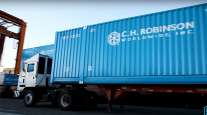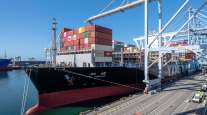Senior Reporter
Nation’s Ports Finish 2020 Strong Amid Surge of Imports

[Stay on top of transportation news: Get TTNews in your inbox.]
The nation’s ports in December posted record or near-record cargo numbers as a surge of imports continued to enter facilities on the Pacific and Atlantic coasts.
Port of Los Angeles, the nation’s busiest, reported the month marked its second-best December on record. The facility moved 879,186 20-foot-equivalent units, up 17.7% from 2019 when longshoremen processed 746,749.
Even though the last three months of 2020 registered as the best quarter ever, the port’s 9,213,395 TEUs moved for the year still were down 1.3% when measured against 2019.
The slight dip can be attributed to the enormous drop-off in containers in March, April and May during the start of the COVID-19 pandemic. It was followed in the fall by a surge of imports as China restarted its economy and American businesses restocked inventories. Consumers were making purchases in traditional brick-and-mortar venues, and e-commerce was surging.
“The consumers continue to spend. We’re seeing the import demand is still strong for household consumption,” IHS Markit Transportation Economist Paul Bingham told Transport Topics. “It’s going right through the supply chain, all the way back to China, where it was the easiest places to get the goods, and the supply chain relationships were there, and the factories in China are open.”

Bingham
In December, the Port of Long Beach notched a 22.6% year-over-year increase, processing 815,885 containers compared with 665,261 a year ago. Because of the heavy influx of cargo, the facility recently announced it had opened a new 40-acre site called the Short Term Overflow Resource yard at Pier S to handle the unprecedented surge in volume.
The Port of Oakland also had a strong month by processing 208,341 TEUs, up 11% compared with 193,953 in December 2019. Officials say the ongoing import boom is being led by high demand for e-commerce items, with many high- and middle-income Bay Area residents continuing to shop online instead of spending on travel, services and social events.
Also on the West Coast, the Northwest Seaport Alliance, which operates the ports of Seattle and Tacoma, reported a solid December, too. The sites moved 6.1% more containers than they did a year ago, loading and unloading 301,814 TEUs compared with 284,452 in 2019.
Even with the increase in volume during the last three months of the year, the ports finished down 12% when measured against 2019. They moved 3,320,379 TEUs in 2020 compared with 3,775,303 a year earlier.
Bingham said even with the year-over-year drop at most ports, he expects 2021 to start with a flourish.
“With the new stimulus coming through Congress, it looks like households will have some money to spend on e-commerce … and with the virus still spreading, we don’t see an end to this anytime soon,” he said.
Congestion at ports on both coasts continues to be a problem, and it has attracted the Federal Maritime Commission’s attention. Commissioners Carl Bentzel and Daniel Maffei recently wrote the World Shipping Council expressing their concerns that ocean carriers refuse to ship American exports because business is so strong on the import side.

Sustainable trucking is here. In this episode, we'll talk to two major players in the transportation technology sector that are helping fleets move closer to total supply chain sustainability. Hear a snippet, above, and get the full program by going to RoadSigns.TTNews.com.
“While we understand the current surge of import cargoes into the United States has stretched our supply chain’s capacity to handle cargo in certain seaports, it is of great concern, if true, that focus on the delivery of surge import cargoes works to the detriment of U.S. exporters,” the letter said.
On the East Coast, the Port of Virginia reported finishing 2020 with a record December. The facility moved 260,401 containers, 15.8% more than 224,902 in 2019.
Overall, 2020 was down 4.2% when measured against 2019 — 2,813,415 containers moved through the port versus 2,937,962 in 2019.
The Port of Charleston’s results were similar to the Port of Virginia’s, for the final month and the entire year.
December saw an 11.6% increase in container volume as 209,606 TEUs were processed compared with 187,882 in 2019. For all of 2020, the port moved 5.2% fewer containers than the year before — 2,309,995 TEUs compared with 2,436,185.
At both facilities, the year-over-year drop was attributed to the decline in the spring during the first months of the pandemic.
Along the Gulf of Mexico, Port Houston also notched a record in the month, handling 264,626 TEUs versus 253,830 in December 2019. For all of 2020, the port moved 2,989,347 TEUs compared with 2,990,175 in 2019.
The Port Authority of New York and New Jersey, the busiest facility on the East Coast, and the Port of Savannah did not report container numbers as of press time.
Want more news? Listen to today's daily briefing:
Subscribe: Apple Podcasts | Spotify | Amazon Alexa | Google Assistant | More




